Variation of Relief Topography and Hardness of Surface Layers of Materials Due to Impact-Oscillatory Loading
Abstract
1. Introduction
2. Methods of Mechanical and Physical Research
3. Research results
- It should be emphasized that steel hardness, compared with the initial state, increases both after static tension and DNP, but with different intensities, Figure 8a,b. This fully agrees with the physical concepts of strain hardening of materials [41,42,43,44,45,46]. Parameter λ = (HVi − HV0)/HV0 × 100% was used to calculate variations in surface hardness after static tension (ST) and DNP + ST. The following values were obtained, Figure 8c. The ε—λ curves have a similar shape, but different curvatures depending on the deformation conditions. This is due to the difference in the mechanisms that control the plastic flow of the material [47,48,49]. In our opinion, when grain `boundaries are improved in the process of DNP, this leads to a decrease in the intensity of surface hardening [50,51]. This fact indicates the presence of relaxation processes on the surface, as well as annihilation and redistribution of dislocations in the surface layers of the material [47,51]. This assumption is confirmed by the results of previous studies, as well as literature data [49]. Thus, at ε = 10–18.2%, the value of λ was from 13.9% to 20.1% for ST, and from 8.7% to 11.7% for DNP.
- The static deformation of steel is of the “classical” type, because surface hardening occurs due to the accumulation of dislocations in the low-angle grain boundaries [52]. This aspect has not been considered in detail, since the analysis of dislocation structures of such steels is described in ref. [53].
- Steels are usually characterized by a tendency to localize strains. As a result, larger volumes of the material are involved in plastic deformation, and a lengthy stage of strain hardening is preserved. The latter allows maintaining a high ultimate strength, albeit less than the initial. Subsequently, the localized accumulation of structural defects leads to a decrease in ductility, which was observed in our case.
- In contrast to the volume of the material, the preceding plastic flow in the surface layer causes the formation of a folded surface structure (microextrusions). In zones of a pronounced local curvature, dislocations appear in the folds, which penetrate deep into the material. As a result, the surface becomes inhomogeneous, because surface irregularities are generally “softer” than those of the base material [54]. Under such conditions, the surface layer is an effective generator of dislocations [47,55]. As a result, small folds disappear on the surface and large ones become smoother, which accelerates the macrolocalization of strain and leads to the fracture of the specimen. It is these factors that cause a decreased ductility of steel 12Kh17 under a constant yield strength and a slight decrease in strength during DNP.
4. Conclusions
Author Contributions
Funding
Acknowledgments
Conflicts of Interest
References
- Korotaev, A.D.; Tyumentsev, A.N.; Gonchikov, V.C.; Olemskoi, A.I. Substructure formation in high-strength dispersely strengthened alloys. Sov. Phys. J. 1991, 34, 244–252. [Google Scholar] [CrossRef]
- Nazarov, A.A. On the role of non-equilibrium grain-boundary structure in the yield and flow stress of polycrystals. Philos. Mag. A 1994, 69, 327–340. [Google Scholar] [CrossRef]
- Metlov, L.S. Thermodynamics of nonequilibrium processes in application to severe plastic deformation. Bull. Russ. Acad. Sci. Phys. 2008, 72, 1283–1287. [Google Scholar] [CrossRef]
- Liu, H.; Pantleon, W.; Mishnaevsky, L., Jr. Non-equilibrium grain boundaries in titanium nanostructured by severe plastic deformation: Computational study of sources of material strengthening. Comput. Mater. Sci. 2014, 83, 318–330. [Google Scholar] [CrossRef]
- Panin, V.E.; Egorushkin, V.E. Nonequilibrium thermodynamics of a deformed solid as a multiscale system. Corpuscular-wave dualism of plastic shear. Phys. Mesomech. 2008, 11, 105–123. [Google Scholar] [CrossRef]
- Yoshida, K. Effects of grain-scale heterogeneity on surface roughness and sheet metal necking. Int. J. Mech. Sci. 2014, 83, 48–56. [Google Scholar] [CrossRef]
- Romanova, V.; Balokhonov, R.; Panin, A.; Kazachenok, M.; Kozelskaya, A. Micro- and mesomechanical aspects of deformation-induced surface roughening in polycrystalline titanium. Mater. Sci. Eng. A 2017, 697, 248–258. [Google Scholar] [CrossRef]
- Mescheryakov, Y.I.; Divakov, A.K.; Zhigacheva, N.I. Shock-induced phase transformation and vortex instabilities in shock-loaded titanium alloy. Int. J. Shock Waves 2000, 10, 43–56. [Google Scholar] [CrossRef]
- Wittridge, N.J.; Knutsen, R.D. A microtexture based analysis of the surface roughening behaviour of an aluminium alloy during tensile deformation. Mater. Sci. Eng. A 1999, 269, 205–216. [Google Scholar] [CrossRef]
- Stoudt, M.R.; Ricker, R.E. The relationship between grain size and the surface roughening behavior of Al-Mg alloys. Metall. Mater. Trans. A 2002, 33, 2883–2889. [Google Scholar] [CrossRef]
- Mescheryakov, Y.I.; Divakov, A.K. Effect of shock-induced phase transformations on dynamic strength of titanium alloys. Int. J. Impact Eng. 2001, 26, 497–508. [Google Scholar] [CrossRef]
- Liu, H.S.; Mishnaevsky, L., Jr. Martensitic transformations in nanostructured nitinol: FE modelling of grain size and distribution effects. Comput. Mat. Sci. 2013, 76, 27–36. [Google Scholar] [CrossRef]
- Vlasov, I.; Panin, S.; Sergeev, V.; Lyubutin, P.; Bogdanov, O.; Maruschak, P.; Ovechkin, B.; Menou, A. Surface layer modification of 12Cr1MoV and 30CrMnSiNi2 steels by Zr+ ion beam to improve the fatigue durability. Procedia Technol. 2015, 19, 313–319. [Google Scholar] [CrossRef]
- Panin, S.V.; Maruschak, P.; Vlasov, I.; Sergeev, V.; Ovechkin, B.; Neifeld, V. Impact toughness of 12Cr1MoV steel. Part 2—Influence of high intensity ion beam irradiation on energy and deformation parameters and mechanisms of fracture. Theor. Appl. Fract. Mech. 2016, 83, 82–92. [Google Scholar] [CrossRef]
- Panin, S.V.; Vlasov, I.V.; Sergeev, V.P.; Maruschak, P.O.; Sunder, R.; Ovechkin, B.B. Fatigue life improvement of 12Cr1MoV steel by irradiation with Zr+ ion beam. Int. J. Fatigue 2015, 76, 3–10. [Google Scholar] [CrossRef]
- Lytvynenko, I.V.; Maruschak, P.O.; Lupenko, S.A. Processing and modeling of ordered relief at the surface of heat-resistant steels after laser irradiation as a cyclic random process. Autom. Control Comput. Sci. 2014, 48, 1–9. [Google Scholar] [CrossRef]
- Becker, R. Effects of strain localization on surface roughening during sheet forming. Acta Mater. 1998, 46, 1385–1401. [Google Scholar] [CrossRef]
- Quazi, M.M.; Fazal, M.A.; Haseeb, A.S.M.A.; Yusof, F.; Masjuki, H.H.; Arslan, A. Laser-based surface modifications of aluminum and its alloys. Crit. Rev. Solid State Mater. Sci. 2016, 41, 106–131. [Google Scholar] [CrossRef]
- Hutsaylyuk, V.; Snieżek, L.; Chausov, M.; Torzewski, J.; Pylypenko, A.; Wachowski, M. Cyclic deformation of aluminium alloys after the preliminary combined loading. Eng. Fail. Anal. 2016, 69, 66–76. [Google Scholar] [CrossRef]
- Hutsaylyuk, V.; Snieżek, L.; Torzewski, J.; Chausov, M.; Berezin, V.; Pylypenko, A. Influence of preliminary combined loading on low cyclic fatigue deformation of aluminum alloy D16ChATV. Procedia Eng. 2015, 114, 18–25. [Google Scholar] [CrossRef][Green Version]
- Zasimchuk, E.; Turchak, T.; Baskova, A.; Chausov, N.; Hutsaylyuk, V. Structural transformations in metallic materials during plastic deformation. J. Mater. Eng. Perform. 2017, 26, 1293–1299. [Google Scholar] [CrossRef]
- Chausov, M.; Hutsaylyuk, V.; Maruschak, P.; Pylypenko, A. Selection of the main controlling parameters of impact-oscillatory loading for maximum improvement of plastic properties of two-phase high-strength titanium alloys. In Proceedings of the 12-th International Conference on Intelligent Technologies in Logistics and Mechatronics Systems, Panevezys, Lithuania, 26–27 April 2018; pp. 55–64. [Google Scholar]
- Chausov, M.G.; Maruschak, P.O.; Pylypenko, A.P.; Khaburs’kyi, Y.M. Influence of dynamic nonequilibrium processes on the mechanical properties and corrosion resistance of titanium alloy. Mater. Sci. 2018, 53, 769–776. [Google Scholar] [CrossRef]
- Partridge, P.G.; Dunford, D.V. Effect of Superplastic Deformation on the Surface Roughness of Sheet; Royal Aerospace Establishment, Procurement Executive, Ministry of Defence: Farnborough, UK, 1988. Available online: http://citeseerx.ist.psu.edu/viewdoc/download?doi=10.1.1.1027.6369&rep=rep1&type=pdf (accessed on 3 August 2019).
- Wouters, O.; Vellinga, W.; Van Tijum, R.; De Hosson, J. On the evolution of surface roughness during deformation of polycrystalline aluminum alloys. Acta Mater. 2005, 53, 4043–4050. [Google Scholar] [CrossRef]
- Shi, Y.; Jin, H.; Wu, P.D.; Lloyd, D.J. Analysis of roping in an AA6111 T4P automotive sheet in 3D deformation states. Acta Mater. 2017, 124, 598–607. [Google Scholar] [CrossRef]
- Chausov, N.G.; Voityuk, D.G.; Pilipenko, A.P.; Kuz’menko, A.M. Setup for testing materials with plotting complete stress–strain diagrams. Strength Mater. 2004, 36, 532–537. [Google Scholar] [CrossRef]
- Chausov, M.G.; Pylypenko, A.P.; Maruschak, P.O. A Method for the Improvement of Plastic Properties of Sheet Two-Phase High-Strength Titanium Alloys Caused by Impact-Oscillatory Loading: Scientific and Methodical Recommendations for the Ukrainian Plants for the Design of Production of Agricultural Equipment; FOP V. A. Palyanytsya: Ternopil, Ukraine, 2017; 48p, Available online: http://elartu.tntu.edu.ua/handle/lib/22618 (accessed on 3 August 2019). (In Ukrainian)
- Chausov, M.G.; Berezin, V.B.; Pylypenko, A.P.; Hutsaylyuk, V.B. Strain field evolution on the surface of aluminum sheet alloys exposed to specific impact with oscillation loading. J. Strain Anal. Eng. Des. 2014, 50, 61–72. [Google Scholar] [CrossRef]
- Lebedev, A.A.; Chausov, N.G.; Zaytseva, L.V. Effect of stressed-state form on failure kinetics and crack resistance in martensitic-aging steel. 1. Study of the failure process stages. Strength Mater. 1991, 23, 833–843. [Google Scholar] [CrossRef]
- Lebedev, A.A.; Chausov, N.G.; Boginich, I.O.; Nedoseka, S.A. Systematic evaluation of the damage to a material during plastic deformation. Strength Mater. 1996, 28, 347–352. [Google Scholar] [CrossRef]
- Chausov, M.; Hutsaylyuk, V.; Sniezek, L.; Pylypenko, A.; Sobchak, A. Strain field evolution on the surface of stainless sheet steel 12Cr17 exposed to a specific impact with oscillation loading. In Proceedings of the 11-th International Conference on Intelligent Technologies in Logistics and Mechatronics Systems, Panevezys, Lithuania, 28–29 April 2016; pp. 47–52. [Google Scholar]
- Chausov, M.G.; Pylypenko, A.P.; Berezin, V.B.; Markashova, L.I.; Kushnariova, O.S.; Hutsaylyuk, V.B. Influence of impact-oscillatory loading upon the mechanical properties of the VT-22 titanium alloy sheet. J. Mater. Eng. Perform. 2016, 25, 3482–3492. [Google Scholar] [CrossRef]
- Chausov, M.; Brezinová, J.; Pylypenko, A.; Maruschak, P.; Titova, L.; Guzanová, A. Modification of mechanical properties of high-strength titanium alloys VT23 and VT23M due to impact-oscillatory loading. Metals 2019, 9, 80. [Google Scholar] [CrossRef]
- Stoudt, M.R.; Levine, L.E.; Creuziger, A.; Hubbard, J.B. The fundamental relationships between grain orientation, deformation-induced surface roughness and strain localization in an aluminum alloy. Mater. Sci. Eng. A 2011, 530, 107–116. [Google Scholar] [CrossRef]
- Stoudt, M.R.; Hubbard, J.B.; Carsley, J.E.; Hartfield-Wünsch, S.E. Characterizing the hemming performance of automotive aluminum alloys with high-resolution topographic imaging. J. Eng. Mater. Technol. 2014, 136, 031001. [Google Scholar] [CrossRef]
- Stoudt, M.R.; Hubbard, J.B.; Iadicola, M.A.; Banovic, S.W. A study of the fundamental relationships between deformation-induced surface roughness and strain localization in AA5754. Metall. Mater. Trans. 2008, 40, 1611–1622. [Google Scholar] [CrossRef]
- Lucachick, G.A.; Sanchez, L.R. Surface topography changes in aluminum alloy sheet during large plastic straining under cyclic pure bending. J. Mater. Process. Technol. 2013, 213, 300–307. [Google Scholar] [CrossRef]
- Sidor, J.J.; Petrov, R.H.; Kestens, L.A. Microstructural and texture changes in severely deformed aluminum alloys. Mater Char 2011, 62, 228–236. [Google Scholar] [CrossRef]
- Shi, Y.; Zhao, P.Z.; Jin, H.; Wu, P.D.; Lloyd, D.J. Analysis of surface roughening in AA6111 automotive sheet under pure bending. Metall. Mater. Trans. A 2016, 47, 949–960. [Google Scholar] [CrossRef]
- Gutierrez-Urrutia, I.; Raabe, D. Multistage strain hardening through dislocation substructure and twinning in a high strength and ductile weight-reduced Fe-Mn-Al-C steel. Acta Mater. 2012, 60, 5791–5802. [Google Scholar] [CrossRef]
- Raabe, D.; Sachtleber, M.; Weiland, H.; Scheele, G.; Zhao, Z. Grain-scale micromechanics of polycrystal surfaces during plastic straining. Acta Mater. 2003, 51, 1539–1560. [Google Scholar] [CrossRef]
- Zhao, Z.; Radovitzky, R.; Cuitino, A. A study of surface roughening in fee metals using direct numerical simulation. Acta Mater. 2004, 52, 5791–5804. [Google Scholar] [CrossRef]
- Efstathiou, C.; Sehitoglu, H.; Lambros, J. Multiscale strain measurements of plastically deforming polycrystalline titanium: Role of deformation heterogeneities. Int. J. Plast. 2010, 26, 93–106. [Google Scholar] [CrossRef]
- Romanova, V.; Balokhonov, R.; Schmauder, S. Numerical study of mesoscale surface roughening in aluminum polycrystals under tension. Mater. Sci. Eng. A 2013, 564, 255–263. [Google Scholar] [CrossRef]
- Jafari, M.; Jamshidian, M.; Ziaei-Rad, S.; Lee, B. Modeling length scale effects on strain induced grain boundary migration via bridging phase field and crystal plasticity methods. Int. J. Solids Struct. 2019, 174, 38–52. [Google Scholar] [CrossRef]
- Steinmetz, D.R.; Jäpel, T.; Wietbrock, B.; Eisenlohr, P.; Gutiérrez-Urrutia, I.; Saeed–Akbari, A.; Hickel, T.; Roters, F.; Raabe, D. Revealing the strain-hardening behavior of twinning-induced plasticity steels: Theory, simulations, experiments. Acta Mater. 2013, 61, 494–510. [Google Scholar] [CrossRef]
- Klevtsov, G.V.; Botvina, L.R.; Botvina, L. Microscopic and macroscopic plastic deformation as a criterion of the limiting state of a material during fracture. Strength Mater. 1984, 16, 473–479. [Google Scholar] [CrossRef]
- Maruschak, P.O.; Okipnyi, I.B.; Poberezhnyi, L.Y.; Maruschak, E.V. Study of heat-resistant steel strain hardening by indentation. Metallurgist 2013, 56, 946–951. [Google Scholar] [CrossRef]
- Aguilar, M.T.P.; Corrêa, E.C.S.; Ferreira, N.A.M.; Monteiro, W.A.; Cetlin, P.R. Work softening of drawn low carbon steel bars. Mater. Res. 2001, 4, 87–91. [Google Scholar] [CrossRef][Green Version]
- Ungár, T.; Li, L.; Tichy, G.; Pantleon, W.; Choo, H.; Liaw, P.K. Work softening in nanocrystalline materials induced by dislocation annihilation. Scr. Mater. 2011, 64, 876–879. [Google Scholar] [CrossRef]
- Zharkova, N.A.; Botvina, L.R.; Tyutin, M.R. Damage accumulation stages in a low-carbon steel during uniaxial tension. Russ. Met. (Metally) 2007, 2007, 223–229. [Google Scholar] [CrossRef]
- Yasniy, P.; Maruschak, P.; Hlado, V. Diagnostics of heat-resistance steel hardening and dislocation structure evolution after plastic deformation. In Proceedings of the WSEAS International Conference “Sustainability in Science Engineering”, Timisoara, Romania, 27–29 May 2009; pp. 47–50. [Google Scholar]
- Okipnyi, I.B.; Maruschak, P.O.; Zakiev, V.I.; Mocharskyi, V.S. Fracture mechanism analysis of the heat-resistant steel 15Kh2MFA(II) after laser shock-wave processing. J. Fail. Anal. Prev. 2014, 14, 668–674. [Google Scholar] [CrossRef]
- Khantuleva, T.A.; Meshcheryakov, Y.I. Nonequilibrium processes in condensed media. Part 2. Structural instability induced by shock loading. Phys. Mesomech. 2016, 19, 69–76. [Google Scholar] [CrossRef]
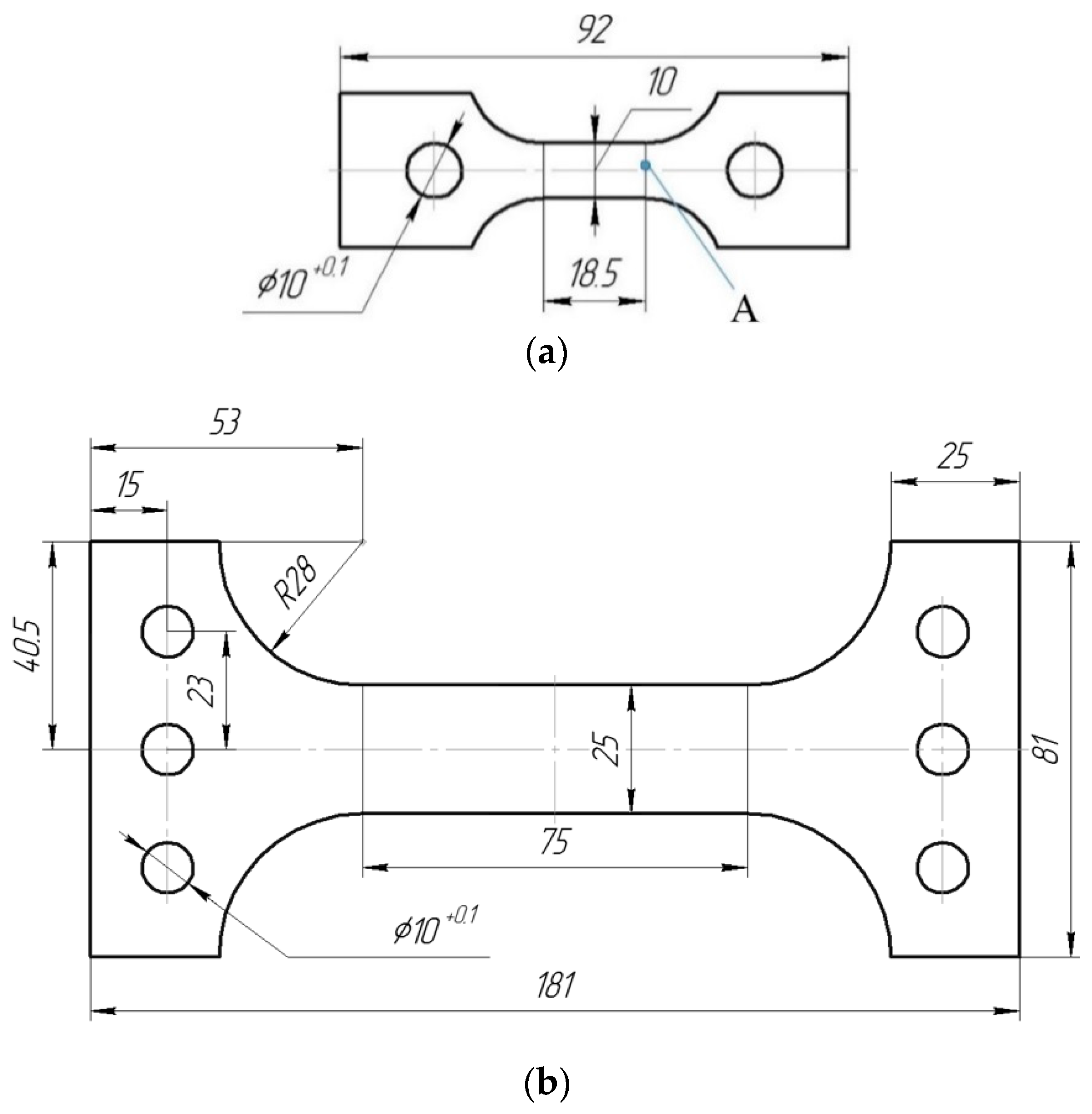
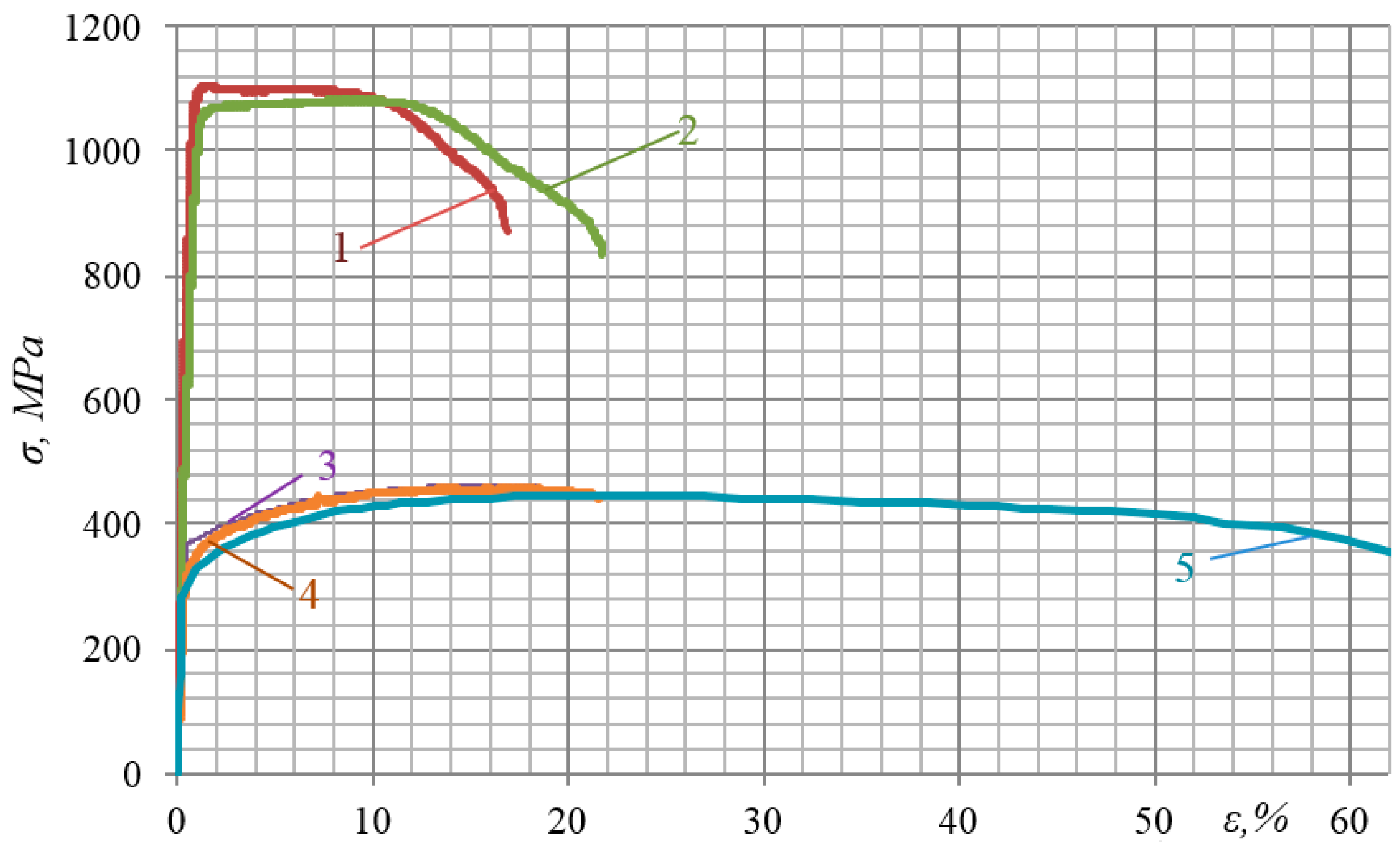
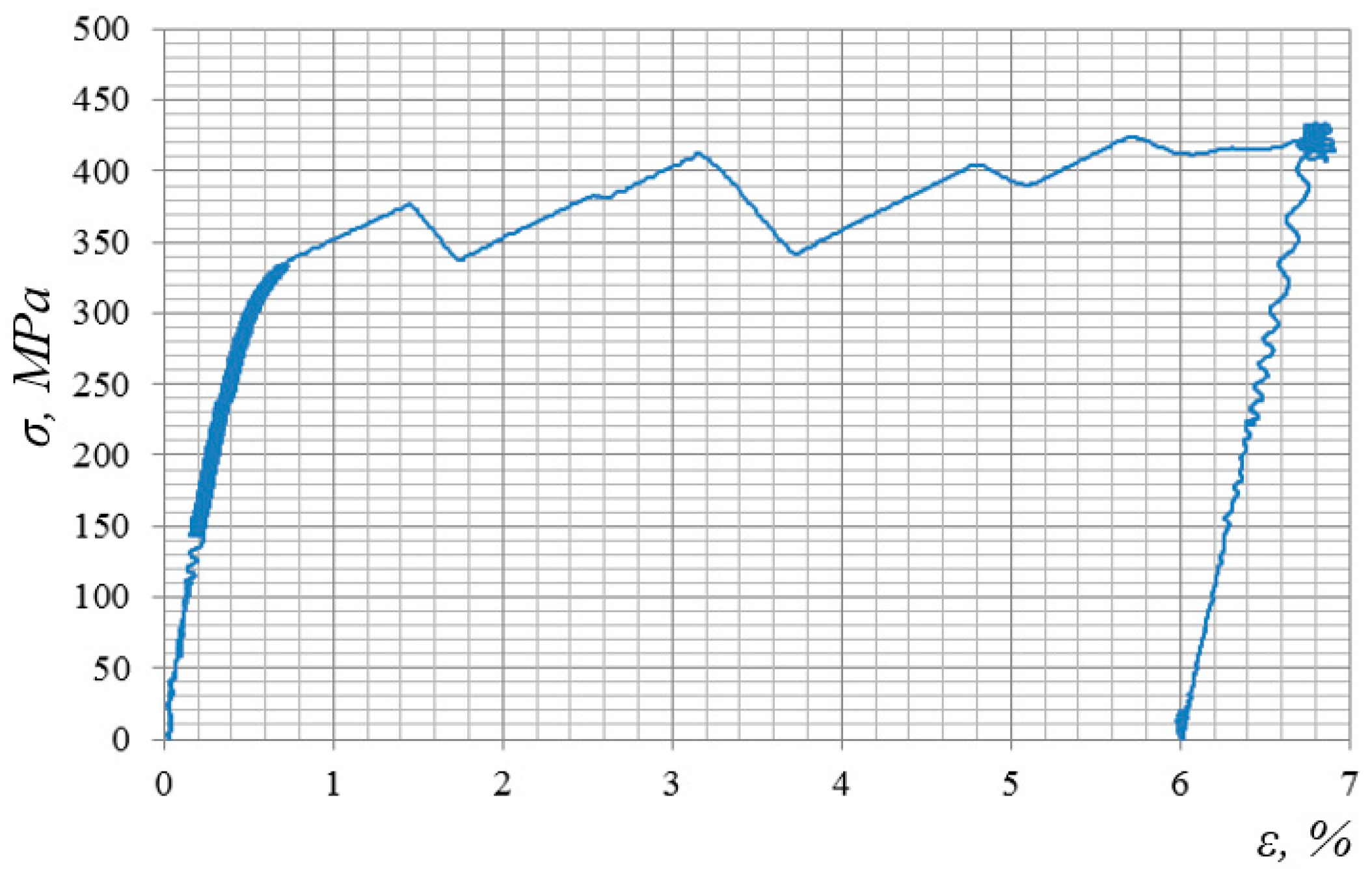


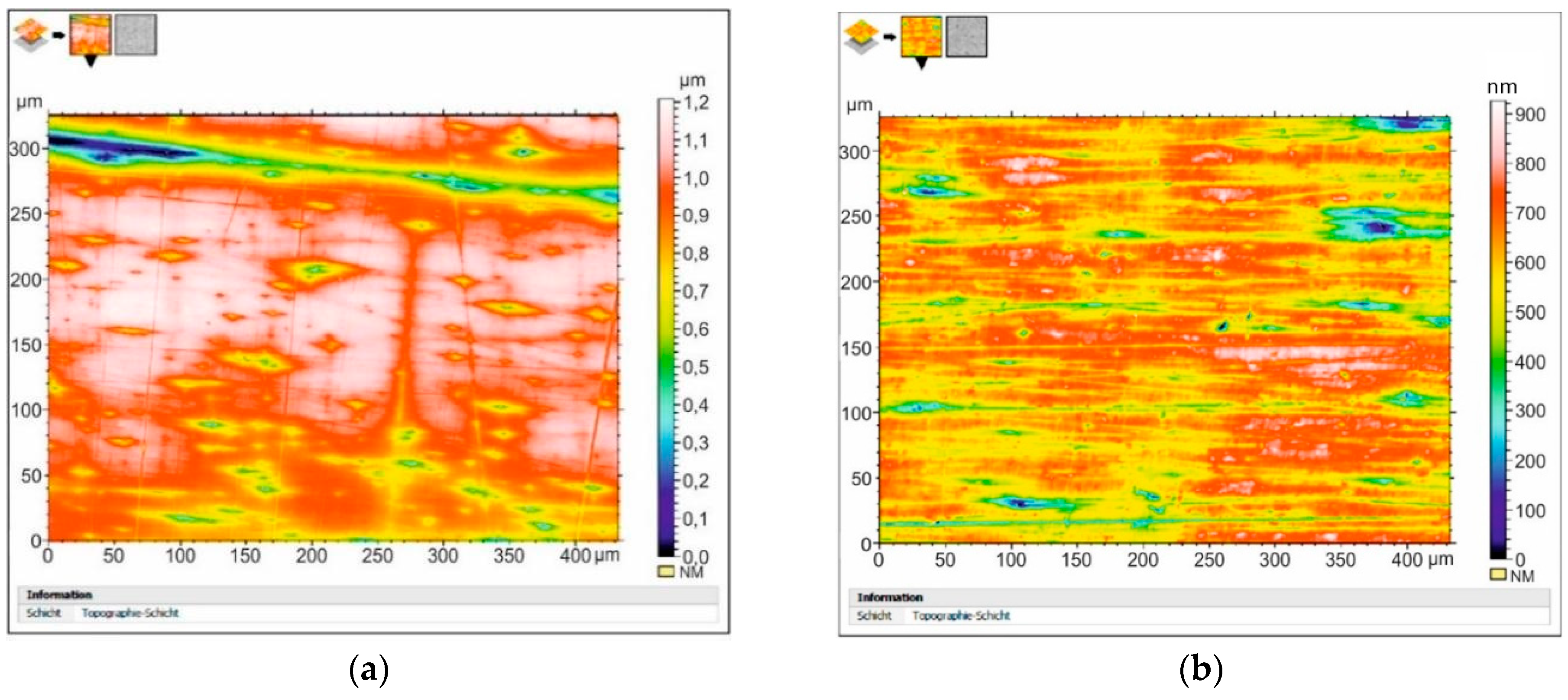
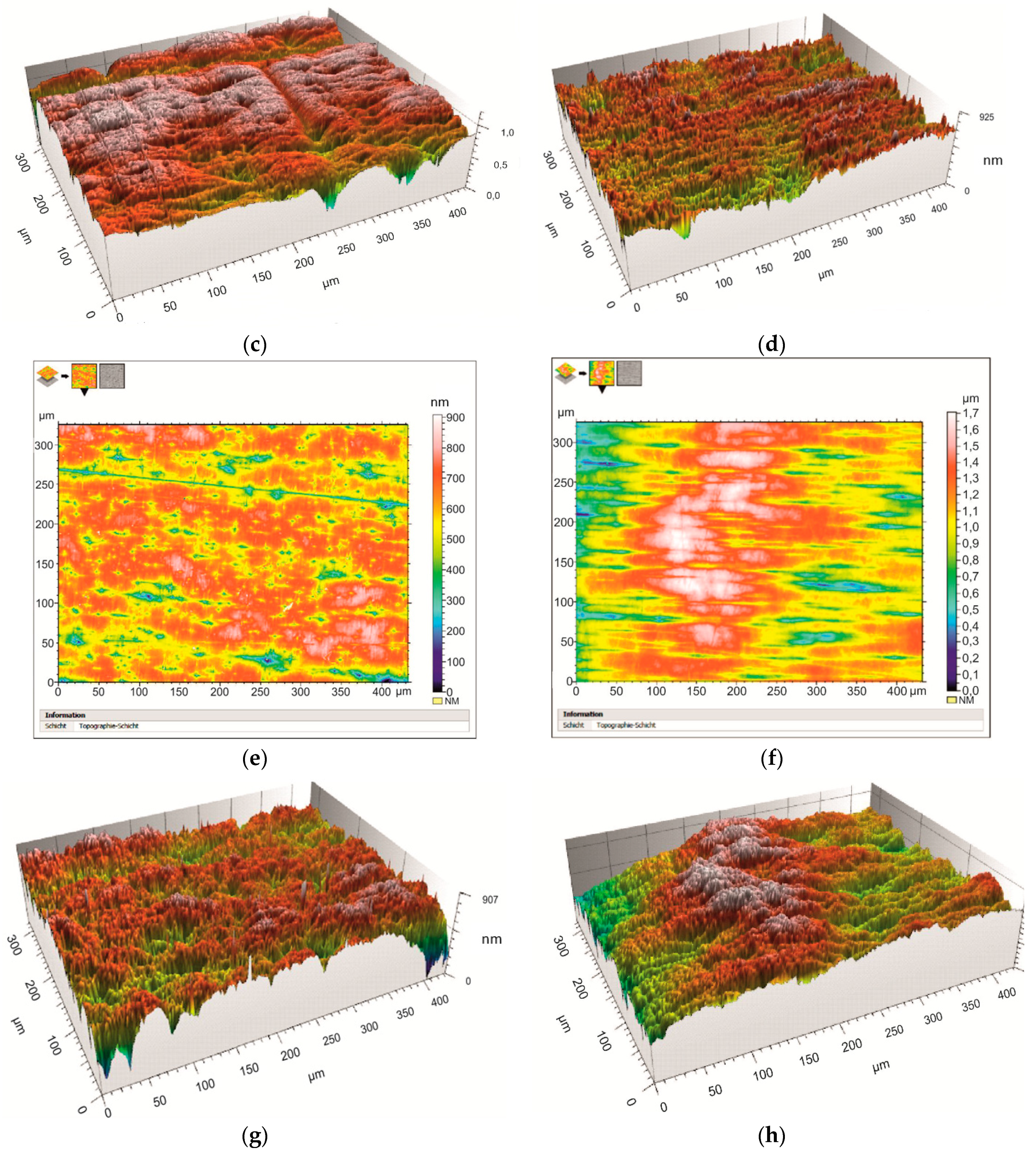


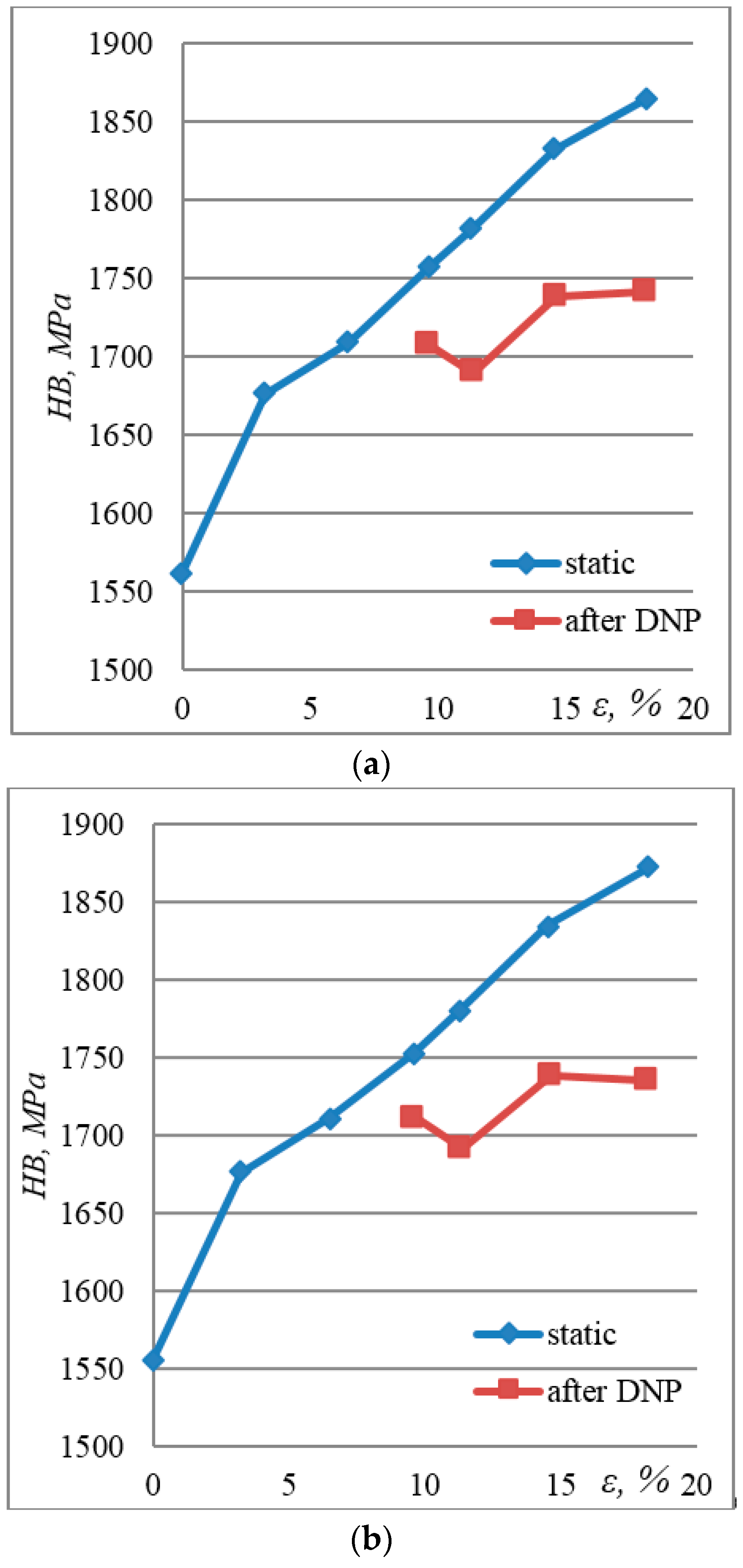

| Materials | σys, MPa | σus, MPa | δ, % |
|---|---|---|---|
| Aluminum alloy 2024-T351 | 342 | 462 | 20.5 |
| Aluminum alloy D16ChATW | 322 | 452 | 21.5 |
| Titanium alloy VT23 | 980 | 1100 | 16.0 |
| Titanium alloy VT23M | 1000 | 1080 | 21.0 |
| Stainless steel 12Kh17 | 280 | 445 | 62.0 |
| Aluminum alloy, % | Si | Fe | Cu | Mn | Mg | Cr | Zn | Ti |
| 2024-T351 | 0.05 | 0.13 | 4.7 | 0.70 | 1.5 | 0.01 | 0.02 | 0.04 |
| D16ChATW | 0.11 | 0.18 | 4.4 | 0.63 | 1.4 | 0.01 | 0.01 | 0.07 |
| Titanium alloy, % | Fe | Cr | Mo | V | Ti | Al | ||
| VT23 | 0.6 | 1.2 | 2.0 | 4.3 | 86.9 | 5.0 | ||
| VT23M | 0.7 | 1.1 | 2.2 | 4.5 | 86.7 | 4.8 | ||
| Stainless steel, % | C | Si | Mn | S | P | Cr | Fe | |
| 12Kh17 | ≤0.12 | ≤0.8 | ≤0.8 | ≤0.025 | ≤0.035 | 16.0–18.0 | ~81.0 | |
| Material | Measurement Area of Profile with the Length of 300 µm | Roughness Parameter Rz | Roughness Parameter Ra | |
|---|---|---|---|---|
| D16CzATW alloy | Initial state | Upper part of topography | 554 | 126 |
| Medium part of topography | 886 | 145 | ||
| Lower part of topography | 533 | 93.5 | ||
| After DNP | Upper part of topography | 757 | 178 | |
| Medium part of topography | 630 | 151 | ||
| Lower part of topography | 822 | 204 | ||
| Aluminum alloy 2024-T351 | Initial state | Upper part of topography | 165 | 18.9 |
| Medium part of topography | 182 | 14.9 | ||
| Lower part of topography | 203 | 18.7 | ||
| after DNP | Upper part of topography | 130 | 17.2 | |
| Medium part of topography | 208 | 21.7 | ||
| Lower part of topography | 164 | 20.6 | ||
| Titanium alloy VT23 | Initial state | Upper part of topography | 113 | 15.1 |
| Medium part of topography | 202 | 34.2 | ||
| Lower part of topography | 101 | 13.3 | ||
| After DNP | Upper part of topography | 154 | 18.2 | |
| Medium part of topography | 112 | 15.7 | ||
| Lower part of topography | 154 | 22.8 | ||
| Titanium alloy VT23M | Initial state | Upper part of topography | 246 | 32 |
| Medium part of topography | 194 | 33 | ||
| Lower part of topography | 259 | 36 | ||
| After DNP | Upper part of topography | 150 | 28.6 | |
| Medium part of topography | 167 | 31.9 | ||
| Lower part of topography | 170 | 32.7 | ||
© 2019 by the authors. Licensee MDPI, Basel, Switzerland. This article is an open access article distributed under the terms and conditions of the Creative Commons Attribution (CC BY) license (http://creativecommons.org/licenses/by/4.0/).
Share and Cite
Chausov, M.; Maruschak, P.; Pylypenko, A.; Brezinová, J.; Bishchak, R.; Burda, I. Variation of Relief Topography and Hardness of Surface Layers of Materials Due to Impact-Oscillatory Loading. Materials 2019, 12, 2720. https://doi.org/10.3390/ma12172720
Chausov M, Maruschak P, Pylypenko A, Brezinová J, Bishchak R, Burda I. Variation of Relief Topography and Hardness of Surface Layers of Materials Due to Impact-Oscillatory Loading. Materials. 2019; 12(17):2720. https://doi.org/10.3390/ma12172720
Chicago/Turabian StyleChausov, Mykola, Pavlo Maruschak, Andrii Pylypenko, Janette Brezinová, Roman Bishchak, and Iurii Burda. 2019. "Variation of Relief Topography and Hardness of Surface Layers of Materials Due to Impact-Oscillatory Loading" Materials 12, no. 17: 2720. https://doi.org/10.3390/ma12172720
APA StyleChausov, M., Maruschak, P., Pylypenko, A., Brezinová, J., Bishchak, R., & Burda, I. (2019). Variation of Relief Topography and Hardness of Surface Layers of Materials Due to Impact-Oscillatory Loading. Materials, 12(17), 2720. https://doi.org/10.3390/ma12172720







